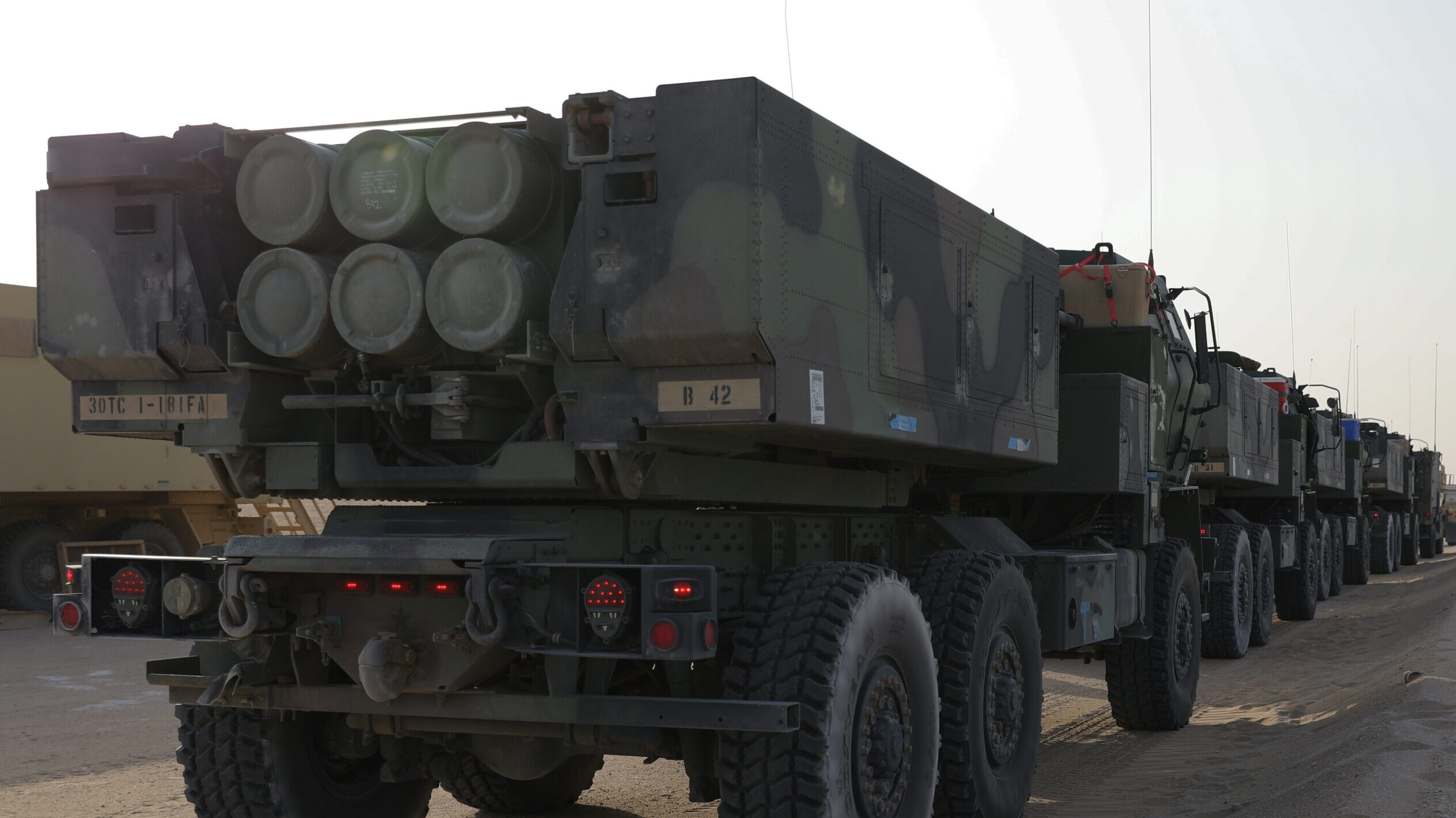
US Army HIMARS launchers, belonging to B Battery, 1-181 Field Artillery Regiment, Task Force Iron Valor, stage before a dry exercise run near Camp Buehring, Kuwait, June 2, 2021. Lawmakers want to provide the Army with the authority to enter into multi-year acquisition contracts on a variety of weapons including HIMARS. (US Army photo by Cpl. Kyle Burks)
WASHINGTON — The US military services are a step closer to having the authority to award non-competitive, multi-year contracts to refill the nation’s dwindling munitions stockpiles and purchase additional launchers such as the M142 High Mobility Artillery Rocket Systems.
On Tuesday night, the House and Senate Armed Services Committees released compromise language for the fiscal 2023 National Defense Authorization Act, which includes the new multiyear procurement authority for “certain munitions.” Lawmakers helpfully spelled out which munitions and launcher lines are candidates for this new buying authority, and the total number of each that the services can acquire.
A move towards multi-year contracting is something many in the Pentagon have advocated for, but Congress has historically been shy about granting such authorities. Calls for doing multiyear buying for munitions have become louder in recent months as the war in Ukraine continues to run through munitions supplies for both America and its partners.
RELATED: Multi-year procurement for munitions would help stabilize industry: LaPlante
“A great advantage of multiyear contracts is [they] usually save a lot of money, you stabilize the industrial base, and you stabilize suppliers because you can get, hopefully, a four- or five-year contract for something versus one year at a time,” Douglas Bush, the assistant secretary of the Army for Acquisition, Logistics and Technology, told reporters during a Nov. 21 roundtable.
“The downside of multiyears, is you don’t quite get as much flexibility year to year but…there are many benefits,” he added.
House and Senate conferees final list includes the following weapons.
- 864,000 XM1128, XM1113, M107, and M795 (155mm rounds)
- 12,000 AGM–179 Joint Air-to-Ground Missiles (JAGM)
- 700 M142 HIMARS
- 1,700 ATACMS
- 2,600 Harpoons
- 1,250 Naval Strike Missiles
- 106,000 Guided Multiple Launch Rocket Systems (GMLRS)
- 3,850 PAC–3 Missile Segment Enhancement weapons
- 5,600 FIM–92 Stinger
- 28,300 FGM–148 Javelin
- 5,100 AIM–120 Advanced Medium Range Air-to-Air Missiles
- 2.2 million Modular Artillery Charge Systems
- 12,050 M982A1 Excalibur
- 950 LRASM
- 3,100 JASSM
- 1,500 Standard Missile–6 (SM–6)
- 5,100 Sidewinder Missiles (AIM–9X)
If the provision ultimately gets signed into law, and adequate funding is included in the defense appropriations bill, companies like Lockheed Martin and Raytheon stand to benefit if they can meet these ambitions production numbers. Lockheed Martin, alone, could reap the financial windfall with a variety of its programs on the approved list including HIMARS launcher, the Patriot Advanced Capability–3 (PAC–3) Missile Segment Enhancement (MSE), the MGM–140 Army Tactical Missile System (ATACMS), the Long Range Anti-Ship Missile (LRASM), the Joint Air-to-Surface Standoff Missile (JASSM) and more.
Of course, just because the NDAA includes this language doesn’t mean a multi-year deal is guarantied, nor at the suggested levels. The appropriations committees still need to provide funding, with the government facing a shutdown on Dec. 16 if no omnibus funding agreement is put in place. And while a multi-year deal should give industry confidence to expand their production lines, that may take time and may never hit the specific levels.
In his November comments, Bush made it clear that he and other military officials presented lawmakers with their “ideas” and “data” to support this new multi-year acquisition authority, with specific weapon systems in mind.
“My experience over the years has been if the department presents a good argument to Congress, they’re often very supportive of multiyear approaches, as long as the numbers add up,” he added. “We’ll have to prove that in each individual case here to where the value of doing the multiyear is demonstrable in terms of cost savings and production stability.”
Senate passes $95 billion foreign aid bill, as DoD eyes next Ukraine weapons package
Additional aid for Ukraine could be made available “within days” said Pentagon Press Secretary Maj. Gen. Pat Ryder earlier today.


























